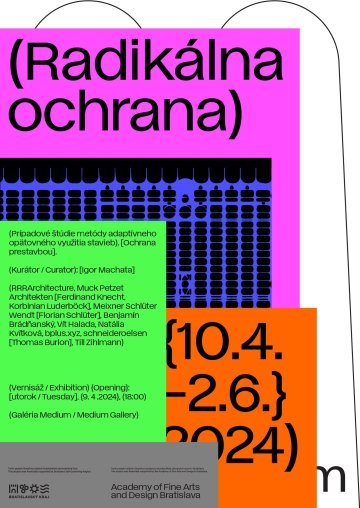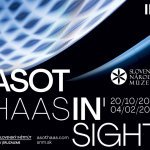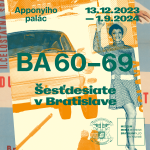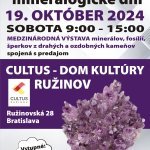Radikálna ochrana
Prípadové štúdie metódy adaptívneho opätovného využitia stavieb
Ochrana prestavbou
Kurátor // Curator: Igor Machata
RRRArchitecture, Muck Petzet Architekten (Ferdinand Knecht, Korbinian Luderböck), Meixner Schlüter Wendt (Florian Schlüter), Benjamín Bradňanský, Vít Halada, Natália Kvítková, bplus.xyz, schneideroelsen (Thomas Burlon), Till Zihlmann
Vernisáž // Exhibition Opening: utorok // Tuesday 9.4.2024, 18:00
Trvanie výstavy // Duration: 10.4. - 2.6.2024
Radikálna ochrana je metóda architektonickej stratégie adaptívneho opätovného využitia existujúcich stavieb, ktorá uvažuje o stavbách ako o procesoch. Každý postavený dom je len jednou fázou vývoja architektonického projektu. Ak dokážeme identifikovať inherentné vlastnosti daných stavieb a mechanizmy ako boli navrhnuté, môžeme ich rozvíjať a vytvárať ďalšiu fázu evolúcie – kontinuálnu stavbu. Cieleným rozvíjaním identifikovaných vlastností dokážeme v rámci transformácie stavby chrániť jej hodnoty. Ochrana prestavbou.
Výstava predstavuje päť prípadových štúdií / architektonických projektov, ktoré sú interpretované ako radikálna ochrana - dve historické (Starý zámok, Mezquita-Catedral) a tri súčasné prípadové štúdie (St. Agnes – Brandlhuber + Emde, Burlon/ Riegler Riewe Architekten; Mäusebunker – bplus.xyz; Dornbuschkirche – Meixner Schlüter Wendt), ktoré popisujú konkrétne možné postupy metódy radikálnej ochrany.
Prípadové štúdie sprevádza súbor doplňujúceho materiálu popisujúci kontext vzniku radikálnej ochrany (Benjamín Brádňanský, Vít Halada). Predstavuje ju ako metódu reagujúcu na klimatickú krízu a tézu antropocénu (Till Zihlmann) a s tým súvisiacimi zmenami architektonickej praxe (RRRArchitecture, Muck Petzet Architekten – Ferdinand Knecht, Korbinian Luderböck). Taktiež má ambíciu priblížiť súčasnú spoločenskú pozíciu voči architektúre neskorého a/alebo socialistického modernizmu (Natália Kvítková) a zadefinovať polohu radikálnej ochrany v kontexte disciplíny pamiatkovej starostlivosti.
Výstavu sprevádza formát diskusií/ prednášok/ prezentácií projektov a tém súvisiacich s radikálnou ochranou z lokálneho kontextu. Informácie o sprievodnom programe budú doplnené čoskoro.
Tento projekt finančne podporil Bratislavský samosprávny kraj.
Tento projekt vznikol s finančnou podporou Vysokej školy výtvarných umení v Bratislave.
//
Radical preservation is a method of adaptive reuse architectural strategy, which considers buildings as processes. Each built house is only one phase in the evolution of an architectural project. If we can identify the inherent qualities of a given building and the mechanisms of how it was designed, we can develop them, in order to create the next phase of evolution – the continued building. By intentional development of the identified qualities, we can protect the values of the building in its transformation. Protection by rebuilding.
The exhibition presents five case studies/ architectural projects that are interpreted as radical preservation – two historical (Starý zámok, Mezquita-Catedral) and three contemporary case studies (St. Agnes – Brandlhuber + Emde, Burlon / Riegler Riewe Architekten; Mäusebunker – bplus.xyz; Dornbuschkirche – Meixner Schlüter Wendt) that illustrate possible practices of the method of radical preservation.
Case studies are accompanied by supplementary material aiming to provide a more thorough description of radical preservation and the context of its origin (Benjamín Brádňanský, Vít Halada). It presents radical preservation as a method reacting to the climate crisis and the thesis of the Anthropocene (Till Zihlmann) and with its impacts on architectural practice (RRRArchitecture, Muck Petzet Architekten – Ferdinand Knecht, Korbinian Luderböck). To outline the current social position towards the late/ socialist modernism architecture (Natália Kvítková) and to define the position of the method in the historical context of heritage preservation discipline.
The exhibition is accompanied by a format of discussions/ lectures/ presentations of projects and themes related to radical preservation from the local context. Information about the accompanying programme will be provided soon.
This project was financially supported by Bratislava Self-Governing Region.
This project was financially supported by the Academy of Fine Arts and Design in Bratislava.
Portál www.kamdomesta.sk nie je organizátorom uverejňovaných podujatí a preto nezodpovedá za zmeny uskutočnené organizátormi. Odporúčame preveriť si vopred termín a čas konania podujatia priamo u organizátora. Na niektoré akcie je potrebné sa prihlásiť vopred.






